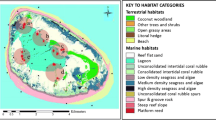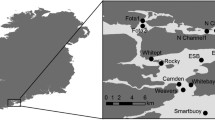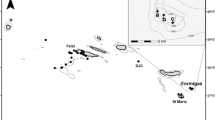Abstract
With climate change resulting in unpredictable sea ice conditions between years, it is crucial to gain a more comprehensive understanding of the subsequent effects on Arctic marine ecosystems. Arctic cod (Boreogadus saida) play a key role in the Arctic marine food web, serving as a food source that is estimated to contribute up to 75 % of energy transfer to higher trophic levels. To investigate Arctic cod residency and distribution in Resolute Bay (74°44′N, 095°04′W), 85 individuals from four locations in the bay were captured, measured, weighed, implanted with acoustic tags and subsequently tracked on an acoustic array of 49 receivers. Two main periods of residence in the bay were identified, the first in open water and the second under ice cover, and both concluded with a collective mass departure of fish. A generalised linear mixed model was used to investigate the influence of variables on Arctic cod presence/absence in the bay, indicating that ingress and egress were influenced by environmental changes, particularly those associated with the transition from open-water to the ice-covered period. Timing and distribution, during the study period, appeared to be influenced by a combination of physiological acclimation, and a balance between resource availability and refuge from predators. Receiver site Residence Index (RI) analysis revealed strong site fidelity of fish towards the northern areas of the bay, and this behaviour was consistent between tagging groups and individuals, indicating that the majority of tagged cod were representative of a single school. This study represents the first employment of acoustic telemetry to monitor the movements of individual Arctic cod over 9 months, incorporating both open-water and ice-covered periods.




Similar content being viewed by others
References
Asselin NC, Barber DG, Stirling I, Ferguson SH, Richard PR (2011) Beluga (Delphinapterus leucas) habitat selection in the eastern Beaufort Sea in spring, 1975–1979. Polar Biol 34:1973–1988. doi:10.1007/s00300-011-0990-5
Bain H, Sekerak A (1978) Aspects of the biology of Arctic cod (Boreogadus saida) in the central Canadian Arctic. LGL Limited, Toronto
Benoit D, Simard Y, Fortier L (2008) Hydroacoustic detection of large winter aggregations of Arctic cod (Boreogadus saida) at depth in ice-covered Franklin Bay (Beaufort Sea). J Geophys Res Oceans 113:C06S90. doi:10.1029/2007JC004276
Benoit D, Simard Y, Gagne J, Geoffroy M, Fortier L (2010) From polar night to midnight sun: photoperiod, seal predation, and the diel vertical migrations of polar cod (Boreogadus saida) under landfast ice in the Arctic Ocean. Polar Biol 33:1505–1520. doi:10.1007/s00300-010-0840-x
Benoit D, Simard Y, Fortier L (2014) Pre-winter distribution and habitat characteristics of polar cod (Boreogadus saida) in southeastern Beaufort Sea. Polar Biol 37:149–163. doi:10.1007/s00300-013-1419-0
Bouchard C, Fortier L (2011) Circum-Arctic comparison of the hatching season of polar cod Boreogadus saida: a test of the freshwater winter refuge hypothesis. Prog Oceanogr 90:105–116. doi:10.1016/j.pocean.2011.02.008
Bouchard C, Mollard S, Suzuki K, Robert D, Fortier L (2014) Contrasting the early life histories of sympatric Arctic gadids Boreogadus saida and Arctogadus glacialis in the Canadian Beaufort Sea. Polar Biol. doi:10.1007/s00300-014-1617-4
Bradstreet M, Finley K, Sekerak AD, Griffiths W, Evans C, Fabijan M, Stallard H (1986) Aspects of the biology of Arctic cod (Boreogadus saida) and its importance in Arctic marine food chains. Can Tech Rep Fish Aquat Sci 1491:1–202
Costello MJ, Coll M, Danovaro R, Halpin P, Ojaveer H, Miloslavich P (2010) A census of marine biodiversity knowledge, resources, and future challenges. PLoS One 5:e12110. doi:10.1371/journal.pone.0012110
Craig PC, Griffiths WB, Haldorson L, McElderry H (1982) Ecological studies of Arctic cod (Boreogadus saida) in Beaufort Sea coastal waters, Alaska. Can J Fish Aquat Sci 39:395–406. doi:10.1139/f82-057
Crawford RE, Jorgenson JK (1993) Schooling behaviour of Arctic cod, Boreogadus saida, in relation to drifting pack ice. Environ Biol Fish 36:345–357. doi:10.1007/BF00012412
Crawford RE, Jorgenson JK (1996) Quantitative studies of Arctic cod (Boreogadus saida) schools: important energy stores in the Arctic food web. Arctic 49:181–193. doi:10.14430/arctic1196
Crawford RE, Vagle S, Carmack EC (2012) Water mass and bathymetric characteristics of polar cod habitat along the continental shelf and slope of the Beaufort and Chukchi seas. Polar Biol 35:179–190. doi:10.1007/s00300-011-1051-9
Drost HE, Carmack EC, Farrell AP (2014) Upper thermal limits of cardiac function for Arctic cod Boreogadus saida, a key food web fish species in the Arctic Ocean. J Fish Biol 84:1781–1792. doi:10.1111/jfb.12397
Ellis EC, Ramankutty N (2008) Putting people in the map: anthropogenic biomes of the world. Front in Ecol Environ 6:439–447. doi:10.1890/070062
Enevoldsen LT, Heiner I, DeVries AL, Steffensen JF (2003) Does fish from the Disko Bay area of Greenland possess antifreeze proteins during the summer? Polar Biol 26:365–370. doi:10.1007/s00300-003-0489-9
Geoffroy M, Robert D, Darnis G, Fortier L (2011) The aggregation of polar cod (Boreogadus saida) in the deep Atlantic layer of ice-covered Amundsen Gulf (Beaufort Sea) in winter. Polar Biol 34:1959–1971. doi:10.1007/s00300-011-1019-9
Goddard SV, Kao MH, Fletcher GL (1992) Antifreeze production, freeze resistance, and overwintering of juvenile northern Atlantic cod (Gadus morhua). Can J Fish Aquat Sci 49:516–522. doi:10.1139/f92-061
Green J, Steele D (1975) Observations on marine life beneath sea ice, Resolute Bay. In: NWT proceedings, circumpolar conference on northern ecology national research council of Canada II, 1975, pp 77–86
Harter BB, Elliott KH, Divoky GJ, Davoren GK (2013) Arctic cod (Boreogadus saida) as prey: fish length-energetics relationships in the Beaufort Sea and Hudson Bay. Arctic 66:191–196. doi:10.14430/arctic4290
He P (1991) Swimming endurance of the Atlantic cod, Gadus morhua L., at low temperatures. Fish Res 12:65–73. doi:10.1016/0165-7836(91)90050-P
Heupel MR, Semmens JM, Hobday AJ (2006) Automated acoustic tracking of aquatic animals: scales, design and deployment of listening station arrays. Mar Freshw Res 57:1–13. doi:10.1071/MF05091
Hop H, Gjøsæter H (2013) Polar cod (Boreogadus saida) and capelin (Mallotus villosus) as key species in marine food webs of the Arctic and the Barents Sea. Mar Biol Res 9:878–894. doi:10.1080/17451000.2013.775458
Judson B (2010) Trends in Canadian Arctic shipping Traffic–Myths and rumours. In: The 20th international offshore (ocean) and polar engineering conference and exhibition, Beijing, China, 2010
Kessel ST, Cooke SJ, Heupel MR, Hussey NE, Simpfendorfer CA, Vagle S, Fisk AT (2014) A review of detection range testing in aquatic passive acoustic telemetry studies. Rev Fish Biol Fish 24:199–218. doi:10.1007/s11160-013-9328-4
Kessel ST, Hussey NE, Webber DM, Gruber SH, Young JM, Smale MJ, Fisk AT (2015) Close proximity detection interference with acoustic telemetry: the importance of considering tag power output in low ambient noise environments. Anim Biotelem 3:5. doi:10.1186/s40317-015-0023-1
Lambert Y, Dutil J-D (2000) Energetic consequences of reproduction in Atlantic cod (Gadus morhua) in relation to spawning level of somatic energy reserves. Can J Fish Aquat Sci 57:815–825. doi:10.1139/f00-022
Matley JK, Crawford RE, Dick TA (2012) Observation of common raven (Corvus corax) scavenging Arctic cod (Boreogadus saida) from seabirds in the Canadian High Arctic. Polar Biol 35:1119–1122. doi:10.1007/s00300-011-1148-1
Matley JK, Fisk AT, Dick TA (2013) The foraging ecology of Arctic cod (Boreogadus saida) during open water (July–August) in Allen Bay, Arctic Canada. Mar Biol 160:2993–3004. doi:10.1007/s00227-013-2289-2
McMullin VA, Munkittrick KR, Methven DA (2009) Latitudinal variability in lunar spawning rhythms: absence of a lunar pattern in the northern mummichog Fundulus heteroclitus macrolepidotus. J Fish Biol 75:885–900. doi:10.1111/j.1095-8649.2009.02338.x
Michaud J, Fortier L, Rowe P, Ramseier R (1996) Feeding success and survivorship of Arctic cod larvae, Boreogadus saida, in the Northeast Water Polynya (Greenland Sea). Fish Oceanogr 5:120–135. doi:10.1111/j.1365-2419.1996.tb00111.x
Nakagawa S, Schielzeth H (2013) A general and simple method for obtaining R2 from generalized linear mixed-effects models. Methods Ecol Evol 4:133–142. doi:10.1111/j.2041-210x.2012.00261.x
Osuga DT, Feeney RE (1978) Antifreeze glycoproteins from Arctic fish. J Biol Chem 253:5338–5343. doi:10.1046/j.1432-1033.2003.03488.x
Parker-Stetter SL, Horne JK, Weingartner TJ (2011) Distribution of polar cod and age-0 fish in the US Beaufort Sea. Polar Biol 34:1543–1557. doi:10.1007/s00300-011-1014-1
Payne N, Gillanders B, Webber D, Semmens J (2010) Interpreting diel activity patterns from acoustic telemetry: the need for controls. Mar Ecol Prog Ser 419:295–301. doi:10.3354/meps08864
Reeves R, Rosa C, George JC, Sheffield G, Moore M (2012) Implications of Arctic industrial growth and strategies to mitigate future vessel and fishing gear impacts on bowhead whales. Mar Policy 36:454–462. doi:10.1016/j.marpol.2011.08.005
Renaud PE, Berge J, Varpe O, Lonne OJ, Nahrgang J, Ottesen C, Hallanger I (2012) Is the poleward expansion by Atlantic cod and haddock threatening native polar cod, Boreogadus saida? Polar Biol 35:401–412. doi:10.1007/s00300-011-1085-z
Stewart EJ, Howell S, Draper D, Yackel J, Tivy A (2007) Sea ice in Canada’s Arctic: implications for cruise tourism. Arctic 60:370–380. doi:10.14430/arctic194
Stroeve J, Holland MM, Meier W, Scambos T, Serreze M (2007) Arctic sea ice decline: faster than forecast. Geophys Res Lett 34:L09501. doi:10.1029/2007GL029703
Thiem J, Taylor M, McConnachie S, Binder T, Cooke S (2011) Trends in the reporting of tagging procedures for fish telemetry studies that have used surgical implantation of transmitters: a call for more complete reporting. Rev Fish Biol Fish 21:117–126. doi:10.1007/s11160-010-9194-2
Turek JG, Center NF (1987) Influence of freshwater inflows on estuarine productivity. National Oceanic and Atmospheric Administration, National Marine Fisheries Service, Northeast Fisheries Center, Woods Hole
Welch HE et al (1992) Energy flow through the marine ecosystem of the Lancaster Sound region, Arctic Canada. Arctic 45:343–357. doi:10.14430/arctic1413
Welch HE, Crawford RE, Hop H (1993) Occurrence of Arctic cod (Boreogadus saida) schools and their vulnerability to predation in the Canadian high Arctic. Arctic 46:331–339. doi:10.14430/arctic1361
Acknowledgments
Support for this project was provided by funding from the Natural Sciences and Engineering Research Council of Canada (NSERC) and Canada Foundation for Innovation (CFI; International Joint Ventures Fund) through the Ocean Tracking Network (OTN), and by the Polar Continental Shelf Program (PCSP), Environment Canada. Permissions from Department of Fisheries and Oceans, Resolute Hunters and Trappers Association and Government of Nunanvut. Field support from Peter and Jeffery Amarualik, Nathaniel Kalluk, Debbie Iqaluk, Robert Currie, Emma Murowinski, Robert Cook, Mia and Tony Gaston. Content consolation and proof reading from Tim Johnson and Abby Nease. A special thank you to all the staff at the PCSP Resolute facility for superb logistical support. We would finally like to thank the editor and three anonymous reviewers for their thorough and highly constructive comments on the earlier draft of this manuscript, which improved the current version.
Author information
Authors and Affiliations
Corresponding author
Additional information
This article belongs to the special issue on the “Ecology of Artic Gadids”, coordinated by Franz Mueter, Jasmine Nahrgang, John Nelson, and Jørgen Berge.
Electronic supplementary material
Below is the link to the electronic supplementary material.
Rights and permissions
About this article
Cite this article
Kessel, S.T., Hussey, N.E., Crawford, R.E. et al. Distinct patterns of Arctic cod (Boreogadus saida) presence and absence in a shallow high Arctic embayment, revealed across open-water and ice-covered periods through acoustic telemetry. Polar Biol 39, 1057–1068 (2016). https://doi.org/10.1007/s00300-015-1723-y
Received:
Revised:
Accepted:
Published:
Issue Date:
DOI: https://doi.org/10.1007/s00300-015-1723-y




